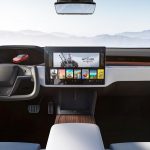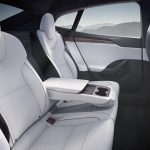
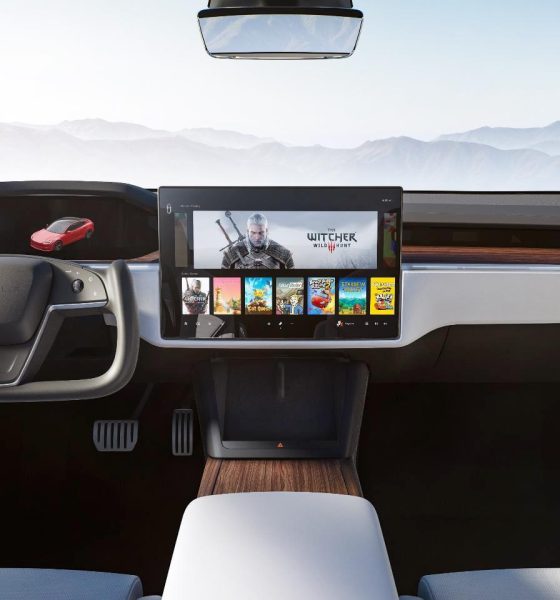
News
Tesla teases Model S Plaid with refreshed interior: New touchscreen, Roadster steering wheel, and more
Tesla revealed new images of the 2021 Refreshed Model S, showing an updated interior with a new, horizontal dash screen, a new steering wheel, wood grain trim, an updated center console, and a rear passenger touchscreen.
The Model S Refresh has been rumored to be taking place for several months. In December, the company shut down Model S and Model X production lines, initiating the thought that its long-standing sedan and SUV would get the updating they deserve.
- Tesla Model S interior touchscreen (refresh) Credit: Tesla
- Tesla Model S interior rear seat touchscreen armrest (Credit: Tesla)
The revamped interior includes a horizontal dash screen, hailing the design from the Model 3 and Model Y. Previously, the Model S and X both had a vertical touchscreen, spanning from the top of the dash to the center console. Tesla has taken a few pieces of inspiration from the new Model 3 interior and a wireless charging mechanism available below the center screen.
The steering wheel is reminiscent of the Tesla Roadster, with its half-circle design. Tesla has also made the Model S interior even more minimalistic than before, removing air-conditioning and heat vents. Utilizing the Airwave HVAC, the new design has the vents hidden and seems also to be inspired by the Model 3 and Model Y interior. The revised system will have tri-zone controls, allowing for customized airflow options for maximum comfortability.
The Model S also received a newly-designed center console that is a clean, one-piece design. The Model 3 also received an updated center console and storage area, using a sliding door design instead of a traditional swinging architecture. For more storage, door pickets have also been added to the Model S, a feature that has long been absent from the sedan.
Three Displays
“With 2200×1300 resolution, ultra-bright colors with exceptional responsiveness and left-right tilt, the new center display is an ideal touchscreen for entertainment and gaming anywhere. A second display in front of the driver shows critical driving information, and a third display provides entertainment and controls for rear passengers.”
Credit: Tesla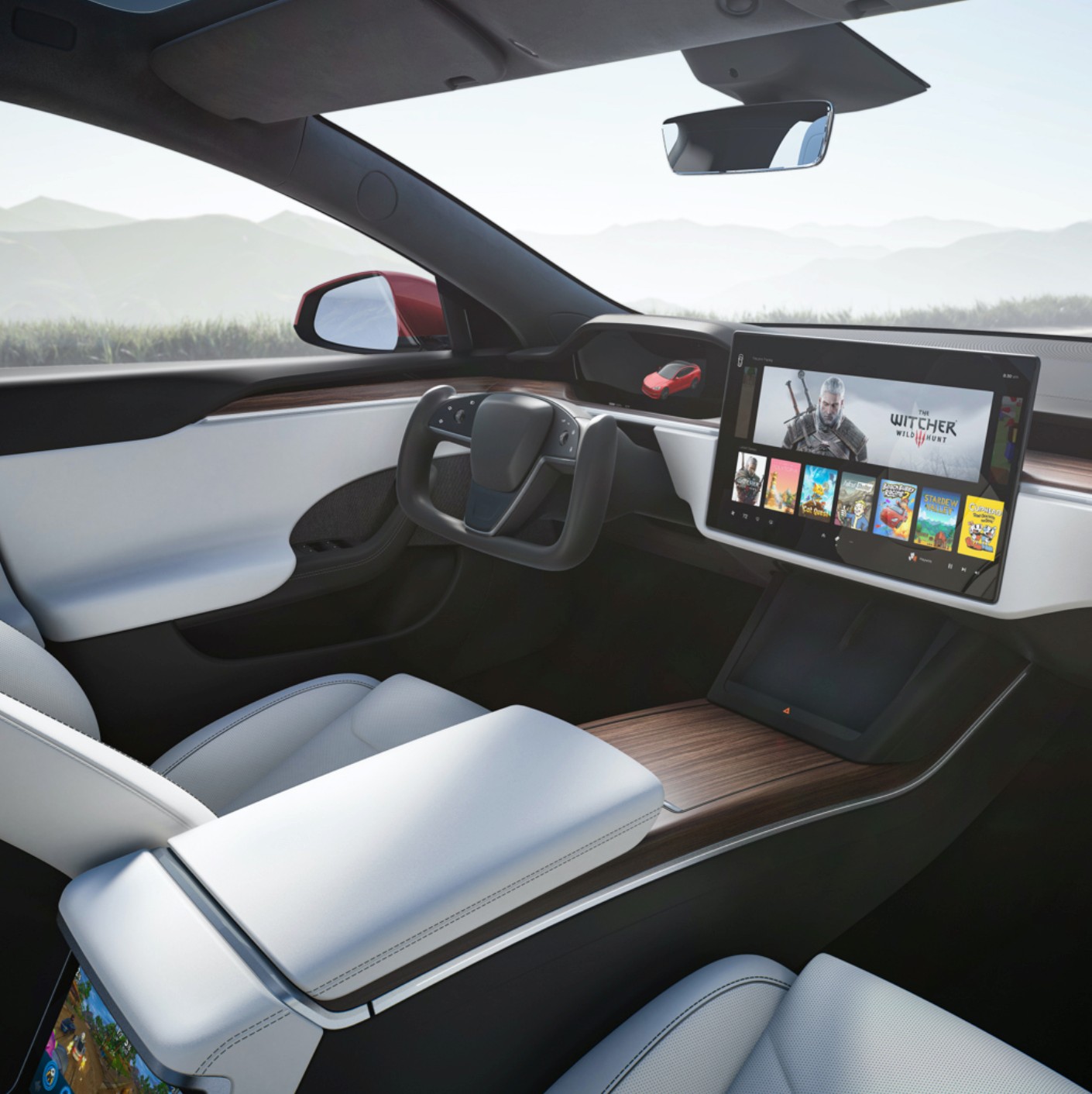
Game from Anywhere
“Up to 10 teraflops of processing power enables in-car gaming on-par with today’s newest consoles via Tesla Arcade. Wireless controller compatibility allows gaming from any seat.”
Credit: Tesla
Tri-Zone Climate Controls
“Airflow and temperature are controlled entirely through the displays without any physical vents. On hot days, Cabin Overheat Protection ensures interiors always stay cool. In cold weather, pre-conditioning automatically warms the cabin and prepares the battery for maximum range.”
Credit: Tesla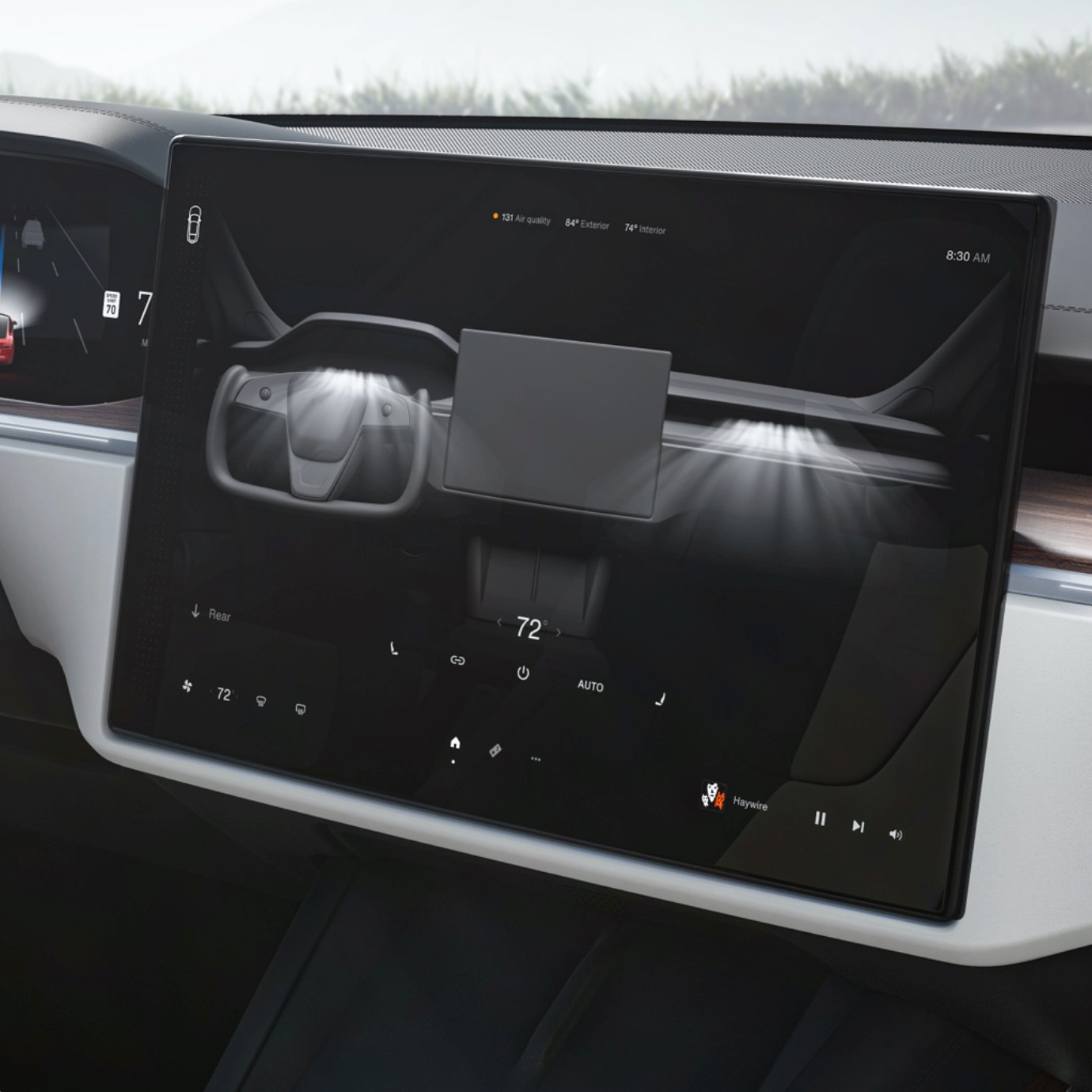
Yoke Steering
“The ultimate focus on driving: no stalks, no shifting. With a stalkless steering yoke, you can enjoy both the best car to drive, and the best car to be driven in.”
Credit: Tesla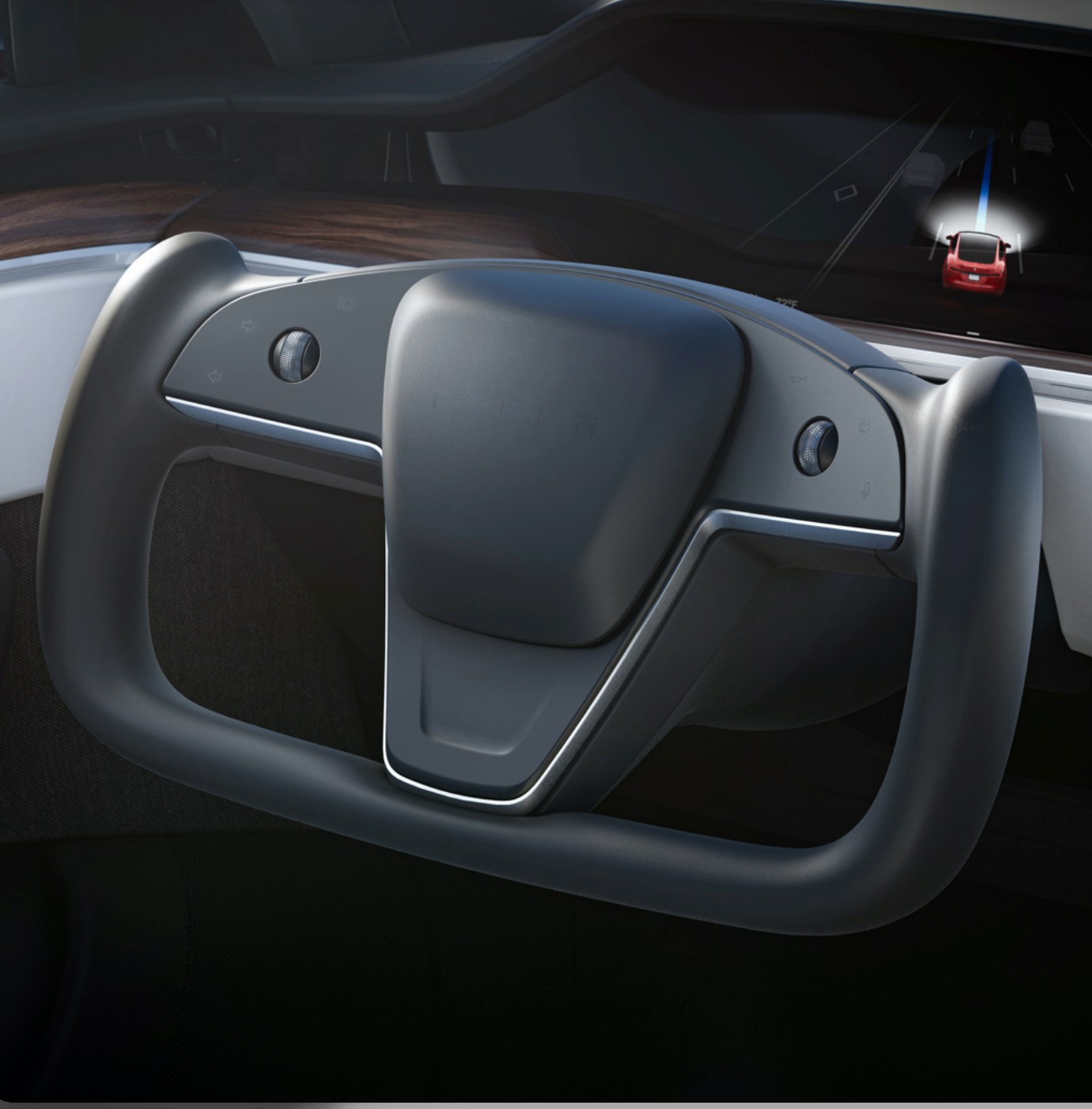
Glass Roof
“The full Glass Roof gives passengers a brighter, more spacious experience and unobstructed views of the sky. Infrared and UV light is effectively blocked before entering the cabin, reducing heat and glare even when the sun is directly overhead.”
Credit: Tesla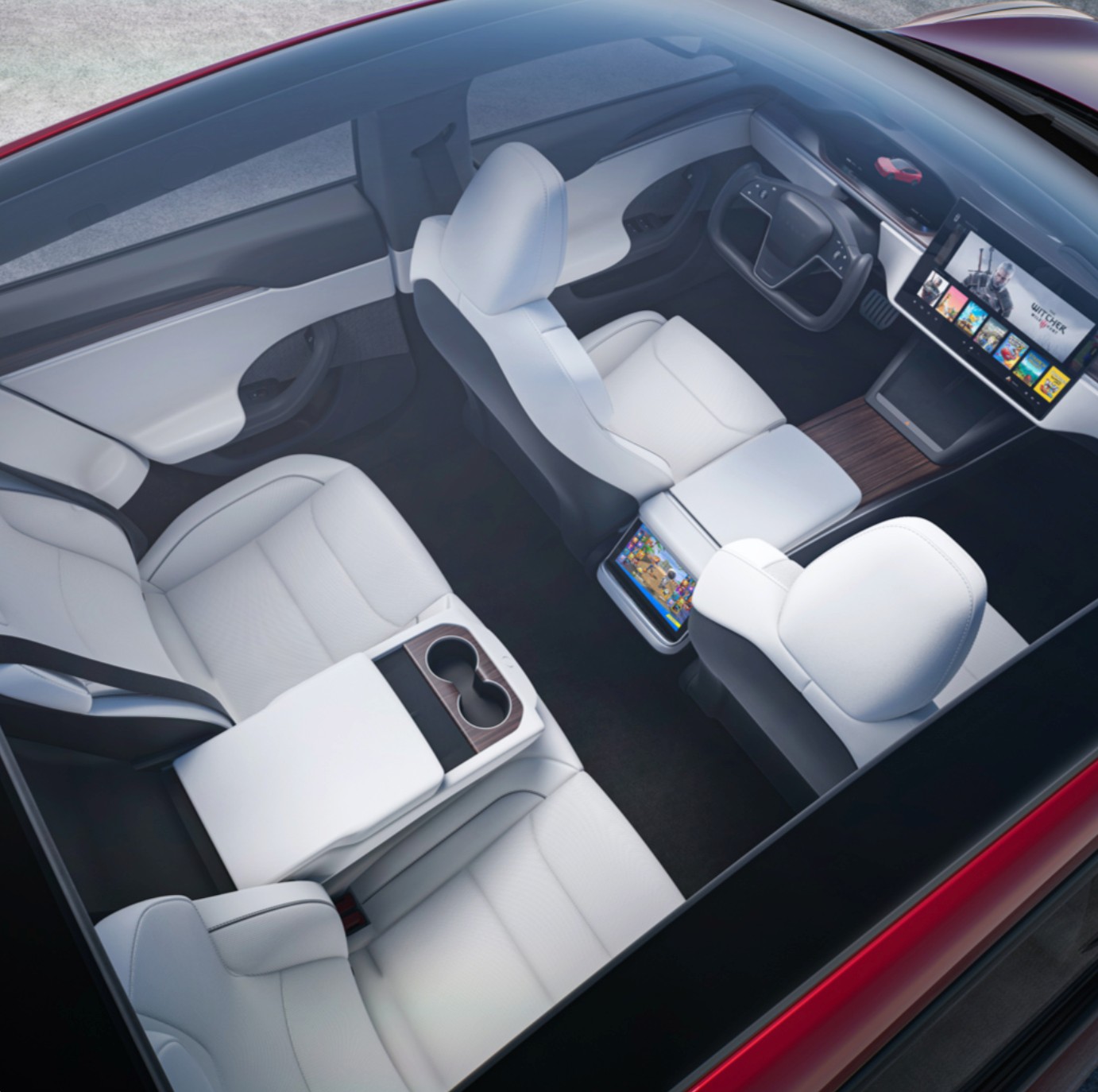
In the rear of the vehicle, the passengers will be given the opportunity to have their own small, centrally-located dash screen, which seems to be displaying a game. This indicates that passengers in the back will not get to miss out on all of the fun that the front occupants have, as they will now be involved in all of the gamification and fun that Tesla offers with its cars. Although not displayed, rear climate controls will also likely be available on this screen, keeping every passenger comfortable.
Teslarati spotted the new Model S at the Fremont Factory this past weekend, showing a newly revised body style that keeps the flagship sedan’s classic look with a few updated features. Wider body designs, coupled with several cosmetic updates, and performance modifications give the Tesla Model S the new design it surely deserves.

News
Waymo sues Santa Monica over order to halt overnight charging sessions
In its complaint, Waymo argued that its self-driving cars’ operations do not constitute a public nuisance, and compliance with the city’s order would cause the company irreparable harm.

Waymo has filed a lawsuit against the City of Santa Monica in Los Angeles County Superior Court, seeking to block an order that requires the company to cease overnight charging at two facilities.
In its complaint, Waymo argued that its self-driving cars’ operations do not constitute a public nuisance, and compliance with the city’s order would cause the company irreparable harm.
Nuisance claims
As noted in a report from the Los Angeles Times, Waymo’s two charging sites at Euclid Street and Broadway have operated for about a year, supporting the company’s growing fleet with round-the-clock activity. Unfortunately, this has also resulted in residents in the area reportedly being unable to sleep due to incessant beeping from self-driving taxis that are moving in and out of the charging stations around the clock.
Frustrated residents have protested against the Waymos by blocking the vehicles’ paths, placing cones, and “stacking” cars to create backups. This has also resulted in multiple calls to the police.
Last month, the city issued an order to Waymo and its charging partner, Voltera, to cease overnight operations at the charging locations, stating that the self-driving vehicles’ activities at night were a public nuisance. A December 15 meeting yielded no agreement on mitigations like software rerouting. Waymo proposed changes, but the city reportedly insisted that nothing would satisfy the irate residents.
“We are disappointed that the City has chosen an adversarial path over a collaborative one. The City’s position has been to insist that no actions taken or proposed by Waymo would satisfy the complaining neighbors and therefore must be deemed insufficient,” a Waymo spokesperson stated.
Waymo pushes back
In its legal complaint, Waymo stated that its “activities at the Broadway Facilities do not constitute a public nuisance.” The company also noted that it “faces imminent and irreparable harm to its operations, employees, and customers” from the city’s order. The suit also stated that the city was fully aware that the Voltera charging sites would be operating around the clock to support Waymo’s self-driving taxis.
The company highlighted over one million trips in Santa Monica since launch, with more than 50,000 rides starting or ending there in November alone. Waymo also criticized the city for adopting a contentious strategy against businesses.
“The City of Santa Monica’s recent actions are inconsistent with its stated goal of attracting investment. At a time when the City faces a serious fiscal crisis, officials are choosing to obstruct properly permitted investment rather than fostering a ‘ready for business’ environment,” Waymo stated.
News
Tesla FSD v14.2.2 is getting rave reviews from drivers
So far, early testers have reported buttery-smooth drives with confident performance, even at night or on twisty roads.

Tesla Full Self-Driving (Supervised) v14.2.2 is receiving positive reviews from owners, with several drivers praising the build’s lack of hesitation during lane changes and its smoother decision-making, among others.
The update, which started rolling out on Monday, also adds features like dynamic arrival pin adjustment. So far, early testers have reported buttery-smooth drives with confident performance, even at night or on twisty roads.
Owners highlight major improvements
Longtime Tesla owner and FSD user @BLKMDL3 shared a detailed 10-hour impression of FSD v14.2.2, noting that the system exhibited “zero lane change hesitation” and “extremely refined” lane choices. He praised Mad Max mode’s performance, stellar parking in locations including ticket dispensers, and impressive canyon runs even in dark conditions.
Fellow FSD user Dan Burkland reported an hour of FSD v14.2.2’s nighttime driving with “zero hesitations” and “buttery smooth” confidence reminiscent of Robotaxi rides in areas such as Austin, Texas. Veteran FSD user Whole Mars Catalog also demonstrated voice navigation via Grok, while Tesla owner Devin Olsen completed a nearly two-hour drive with FSD v14.2.2 in heavy traffic and rain with strong performance.
Closer to unsupervised
FSD has been receiving rave reviews, even from Tesla’s competitors. Xpeng CEO He Xiaopeng, for one, offered fresh praise for FSD v14.2 after visiting Silicon Valley. Following extended test drives of Tesla vehicles running the latest FSD software, He stated that the system has made major strides, reinforcing his view that Tesla’s approach to autonomy is indeed the proper path towards autonomy.
According to He, Tesla’s FSD has evolved from a smooth Level 2 advanced driver assistance system into what he described as a “near-Level 4” experience in terms of capabilities. While acknowledging that areas of improvement are still present, the Xpeng CEO stated that FSD’s current iteration significantly surpasses last year’s capabilities. He also reiterated his belief that Tesla’s strategy of using the same autonomous software and hardware architecture across private vehicles and robotaxis is the right long-term approach, as it would allow users to bypass intermediate autonomy stages and move closer to Level 4 functionality.
News
Elon Musk’s Grok AI to be used in U.S. War Department’s bespoke AI platform
The partnership aims to provide advanced capabilities to 3 million military and civilian personnel.

The U.S. Department of War announced Monday an agreement with Elon Musk’s xAI to embed the company’s frontier artificial intelligence systems, powered by the Grok family of models, into the department’s bespoke AI platform GenAI.mil.
The partnership aims to provide advanced capabilities to 3 million military and civilian personnel, with initial deployment targeted for early 2026 at Impact Level 5 (IL5) for secure handling of Controlled Unclassified Information.
xAI Integration
As noted by the War Department’s press release, GenAI.mil, its bespoke AI platform, will gain xAI for the Government’s suite of tools, which enable real-time global insights from the X platform for “decisive information advantage.” The rollout builds on xAI’s July launch of products for U.S. government customers, including federal, state, local, and national security use cases.
“Targeted for initial deployment in early 2026, this integration will allow all military and civilian personnel to use xAI’s capabilities at Impact Level 5 (IL5), enabling the secure handling of Controlled Unclassified Information (CUI) in daily workflows. Users will also gain access to real‑time global insights from the X platform, providing War Department personnel with a decisive information advantage,” the Department of War wrote in a press release.
Strategic advantages
The deal marks another step in the Department of War’s efforts to use cutting-edge AI in its operations. xAI, for its part, highlighted that its tools can support administrative tasks at the federal, state and local levels, as well as “critical mission use cases” at the front line of military operations.
“The War Department will continue scaling an AI ecosystem built for speed, security, and decision superiority. Newly IL5-certified capabilities will empower every aspect of the Department’s workforce, turning AI into a daily operational asset. This announcement marks another milestone in America’s AI revolution, and the War Department is driving that momentum forward,” the War Department noted.
